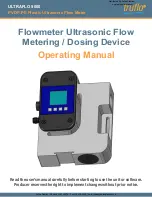
Remote Commands
R&S
®
ZNH
195
User Manual 1334.5985.02 ─ 02
ple GET (Group Execute Trigger) is only executed after the commands received
before. Each recognized command is immediately transferred to the internal instrument
settings data base but not executed immediately.
The command recognition detects syntax errors in the commands and transfers them
to the status reporting system. The rest of a program message after a syntax error is
analyzed further if possible and serviced. After the syntax test, the value range of the
parameter is checked, if necessary.
If the command recognition detects a delimiter, it passes the command to an execution
unit that performs the instrument settings. In the meantime, the command recognition
is ready to process new commands (overlapping execution). A DCL command is pro-
cessed in the same way.
12.3.3
Data Base and Instrument Hardware
Here the expression "instrument hardware" denotes the part of the instrument fulfilling
the actual instrument function - signal generation, measurement etc. The controller is
not included. The term "data base" denotes a database that manages all the parame-
ters and associated settings required for setting the instrument hardware.
Setting commands lead to an alteration in the data set. The data set management
enters the new values (e.g. frequency) into the data set, however, only passes them on
to the hardware when requested by the command recognition. This only takes place at
the end of a program message.
The data are checked for compatibility with the current instrument settings before they
are transmitted to the instrument hardware. If the execution is not possible, an "execu-
tion error" is signaled to the status reporting system. The corresponding settings are
discarded.
Before passing on the data to the hardware, the settling bit in the STATus:OPERation
register is set (refer to section
ware executes the settings and resets the bit again as soon as the new state has set-
tled. This fact can be used to synchronize command servicing.
Queries induce the data set management to send the desired data to the output unit.
12.3.4
Status Reporting System
For detailed information, refer to
12.3.5
Output Unit
The output unit collects the information requested by the controller, which it receives
from the data base management. The output unit processes the information according
to the SCPI rules and makes it available in the output buffer.
If the instrument is addressed as a talker without the output buffer containing data or
awaiting data from the data base management, the output unit sends error message
Instrument Model and Command Processing
















































